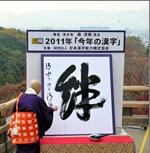DISCOVERY OF THE MONTH

WASBE 2005 COMMISSION REDISCOVERED
What is KIZUNA?
In a disaster-ridden year that brought a nation closer together, the Chinese character "kizuna" (bonds between people) has been selected as the kanji that best reflects the events of 2011, the Japan Kanji Aptitude Testing Foundation announced Dec. 12. The kizuna kanji was written on a giant piece of Japanese paper using Japanese ink on the same day by Seihan Mori, the chief priest of Kiyomizudera temple, a World Heritage site, in Kyoto’s Higashiyama Ward.

In 2005, one of the outstanding works of the WASBE Conference was Kizuna by Frederick Speck. Commissioned by the World Association for Symphonic Bands and Ensembles (WASBE), it received its premiere by the Senzoku Gakuen College of Music Wind Ensemble at the 2005 WASBE conference in Singapore, conducted by WASBE President, Dennis Johnson.
The work celebrated the spirit of the Singapore Conference, with imagery of an east/west confluence of ideas central to its expression. The music merges eastern and western nuances in tonal languages that freely embrace one another and are at times, musically “inter-lingual.” Though much of the work unfolds by revealing solo passages that allow individual personalities to be exposed, the music also develops a sense of physical strength through several notable tutti sections, the greatest of which concludes the work. This process of joining together and gaining strength is reflected by the title, Kizuna, a Japanese word which means a kind of connection between people resulting in the creation of a strong bond. It is derived from the roots “ki” which means trees and “tsuna” or “zuna” which means ropes.
Adam Gorb reviewed the premiere, citing that the world premiere of Kizuna by USA composer Frederick Speck left a strong impression. What I particularly enjoyed in this colourful work was the rhythmic freedom and avoidance of predictable ostinato patterns that can mar so many serious wind ensemble works. It was also a considerable achievement to keep the ear so stimulated with a predominantly pentatonic language.
Kizuna has also been featured with a performance analysis in Teaching Music through Performance in Band, Vol. 7, which is published by GIA. The author, Dr. Amy Acklin, draws attention to its process of accumulating energy, the most monumental of these… concluding Kizuna with layers of brilliant and searing rising scales.